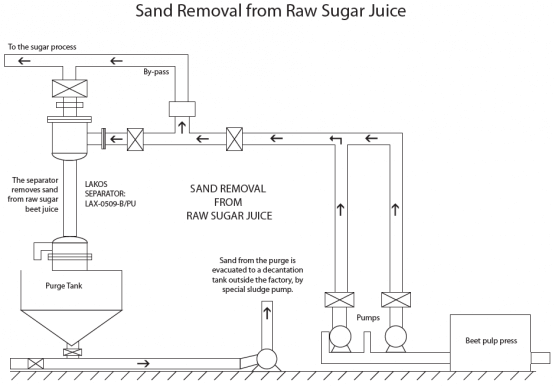Sugar Cane Mill Decreases Waste & Increases Efficiency with LAKOS

Sugar Cane Mills Decreases Waste and Increases Efficiency with LAKOS
EXAMPLE #1
Application: Pre-filtration to clarification process and protection of downstream pumps, impellers, and heat exchangers
System Identification: LAKOS Dual Stage Stainless Steel Super Separators (Two-Stage JPX System) and purge handling equipment
Solids: Sand, grit, and very fine sugar cane bagasse Liquid: Raw sugar cane juice
Problem/Challenge: Sugar cane juice with high levels of extraneous matter (soil, dirt, grit) impacts the capacity and efficiency of milling, processing and boiler operations.
When sugar cane is cut and taken to the sugar mill for processing, different quantities of dirt, solids and grit are loaded with the stalks, depending on the harvesting mechanization and weather conditions. Despite the pre-crush washing process, large amounts of solids are carried into the juice extraction process.
Juice clarification is an important step in sugar production. Heavy solids contamination — sand, grit, and very fine sugar cane bagasse — must be separated from the raw juice in order to ensure the best quality final product. Typically, a strainer (DSM, rotational or vibration) is used after the crushing and prior to the clarification process. These strainers use various screen mesh (0.2mm to 0.7mm). A LAKOS high performance dual stage, Super Separator configuration and purge handling equipment is installed between the strainer and the clarifier, removing the bulk of the solids from the raw juice prior to the juice reaching the clarification process. The clarification process is used to remove small impurities that may be soluble, colloidal or insoluble.
Effective solids handling of the removed solids from the LAKOS system allows sugar mills to reclaim valuable sugar cane juice from the solids and limit valuable juice loss, saving money.
The use of a LAKOS dual stage Super Separator in the pre-treatment stages of sugar cane milling processes provides the following benefits:
- Reduce the solids load of separable solids 98% of 44 micron on the clarifiers
- Allow the clarifiers to work more efficiently on smaller impurities, soluble and colloidal materials.
Sugar Cane Mills Decreases Waste and Increases Efficiency with LAKOS
EXAMPLE #2
Application: LAKOS installed in the Clean-In-Place system
Solids: Scale and chemical fouling Liquid: CIP liquid cleaning solution
LAKOS Solution: LAKOS Stainless Steel Separators and purge handling equipment.
Heat exchangers are used for pre-heating the juice before being fed to the first unit of the evaporation line. The evaporation process leads to the formation of mineral and silt deposits, leading to fouling on the inner surface of the evaporator tubes. Mineral deposits inside the tubes act as insulation, thus causing higher heat transfer resistance. As a consequence of the formation of solid deposits on heating surfaces, evaporative rates decrease with time. It is important in sugar processing environments to keep the heat transfer capability as high as possible. The common practice to mitigate fouling is to implement automatic clean-in-place (CIP) operations.


